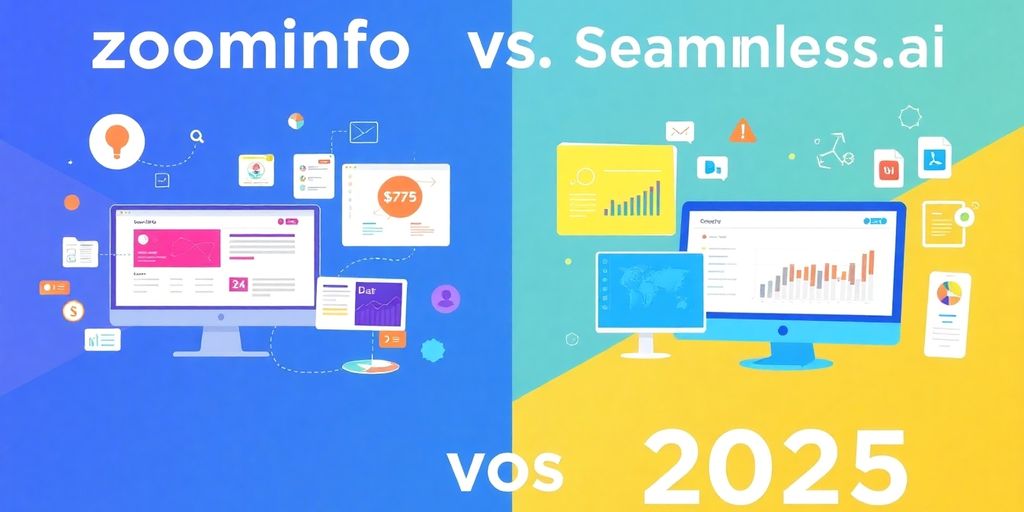Last updated on May 26th, 2025 at 06:55 am
As we move into 2025, businesses are looking for ways to boost productivity and streamline operations. One of the best ways to achieve this is by using AI agents.
These platforms enable you to automate tasks, manage data, and enhance customer interactions without needing extensive technical know-how. In this article, we’ll explore how to find the best AI agent platform for your business needs, whether you’re a small startup or a large enterprise.
Key Takeaways
- Identify your specific needs before choosing an AI agent platform.
- Relay.app is great for beginners due to its user-friendly design.
- Gumloop offers advanced automation features for more complex tasks.
- Agent.ai provides a community-driven marketplace for ready-to-use AI agents.
- Always evaluate pricing models to ensure you get the best value for your investment.
Identifying Your Business Needs

Before you even think about diving into the world of AI agent platforms, you gotta take a step back. Like, way back. It’s all about figuring out what your business actually needs. No point in getting fancy tech if it doesn’t solve a real problem, right?
Understanding Automation Goals
Okay, so what do you want to automate? Don’t just say “everything!” Think specific. Is it customer support? Lead generation? Data entry? Pinpointing your automation goals is the first step. Make a list. Prioritize it. What’s costing you the most time and money right now? What’s causing the biggest headaches? Those are the areas to focus on. For example:
- Reduce customer support response time.
- Automate invoice processing.
- Improve lead qualification.
Evaluating Current Workflows
Alright, now that you know what you want to automate, let’s look at how things are done now. Map out your current workflows. All of them. Even the messy ones.
Where are the bottlenecks? Where are things getting stuck? Where are people spending way too much time on repetitive tasks? Understanding your current workflows will help you see where an AI agent can actually make a difference.
Think about it like this: you can’t fix a problem if you don’t know where it is. Consider using process mapping software to visualize these workflows. This will make it easier to identify areas ripe for automation.
You might find that some processes are already pretty efficient and don’t need much help, while others are screaming for automation. This evaluation is key to building an AI agent that fits your business.
Determining Budget Constraints
Let’s talk money. How much are you willing to spend on an AI agent platform? Be realistic. Don’t just look at the initial cost. Think about the long-term costs too. Training, maintenance, integration – it all adds up.
And don’t forget to factor in the potential return on investment (ROI). Will the AI agent save you enough time and money to justify the cost? If not, it might not be worth it. Here’s a simple table to help you think about it:
| Expense | Estimated Cost | Notes |
|---|---|---|
| Platform Subscription | $X/month | Varies depending on features and usage. |
| Implementation & Training | $Y | One-time cost for setup and training employees. |
| Maintenance | $Z/month | Ongoing costs for updates, support, and troubleshooting. |
| Total Estimated Cost | $X + $Y + $Z | Consider this against potential savings from automation. |
It’s easy to get caught up in the excitement of new technology, but it’s important to stay grounded and make sure that any AI solution you choose fits within your budget and provides a clear return on investment. Otherwise, you’re just throwing money away.
Exploring Top AI Agent Platforms

Okay, so you’re ready to jump into the world of AI agents. Great! But with so many platforms popping up, how do you even choose? Let’s look at a few that are making waves in 2025. I’ll give you the lowdown on Relay.app, Gumloop, and Agent.ai. Each has its own strengths, so hopefully, this will help you narrow down your options.
Relay.app for User-Friendly Solutions
Relay.app is all about ease of use. It’s designed for people who want to build AI-powered workflows without needing to code. Think of it as a drag-and-drop interface where you can automate tasks and integrate AI for things like content creation or data extraction. It also emphasizes human oversight, which is nice. Here’s what I like about it:
- Intuitive interface
- Focus on human-in-the-loop control
- Pre-built capabilities to get you started quickly
Relay.app seems like a solid choice if you want to get your feet wet without a steep learning curve. It’s great for automating routine tasks and integrating AI in a controlled way.
Gumloop for Advanced Automations
If you’re looking for something a bit more powerful, Gumloop might be your thing. It’s geared towards more advanced automations. While Relay.app is great for simple workflows, Gumloop lets you build more complex systems. It’s not quite as beginner-friendly, but the extra power is worth it if you need it. Consider these points:
- More complex automation capabilities
- Suitable for users with some technical background
- Focus on building sophisticated AI systems
Agent.ai for Community-Driven Development
Agent.ai is a bit different. It’s more of a marketplace and community for AI agents. The Agent Network AI agent marketplace lets you find pre-built AI agents for various use cases. It also has an Agent Builder, so you can create and publish your own agents. It’s a cool idea, especially if you want to collaborate with others. Here’s the deal:
- Community-driven approach
- Marketplace for pre-built agents
- Low-code agent builder for creating your own
Assessing Features and Capabilities
Alright, so you’ve got a handle on what you need and you’ve checked out some platforms. Now it’s time to get down to brass tacks: what can these AI agent platforms actually do? It’s not just about the flashy demos; it’s about whether they fit into your existing setup and can grow with you.
No-Code vs. Low-Code Options
This is a big one. Do you want something you can drag-and-drop your way to success with, or are you comfortable getting your hands a little dirty with some code? No-code platforms are great for quick wins and empowering non-technical teams. Low-code gives you more flexibility but requires some technical know-how. The right choice depends entirely on your team’s skills and your project’s complexity.
Integration with Existing Tools
Can the platform play nice with the tools you already use? Think about your CRM, your project management software, your data analytics platforms. If an AI agent platform can’t integrate with existing tools, you’re looking at a lot of manual data transfer and potential headaches. Here’s a quick checklist:
- Does it connect to your CRM?
- What about your marketing automation platform?
- Can it access your databases?
- Does it support the file formats you use?
Customization and Scalability
Out-of-the-box solutions are great, but what happens when your needs evolve? Can you tweak the platform to fit your specific workflows? Can it handle a growing workload without breaking a sweat? Scalability is key. You don’t want to be stuck with a platform that can’t keep up with your success.
Think about your long-term vision. Where do you see your business in five years? Will the AI agent platform you choose today still be a good fit then? Consider factors like the platform’s ability to handle increased data volume, support more users, and adapt to new use cases. It’s better to invest in a solution that can grow with you than to constantly be switching platforms.
Evaluating User Experience and Support
It’s easy to get caught up in features and pricing, but don’t forget the human element! How easy is the platform to use, and what kind of help can you expect when things go wrong? These are critical questions.
User Interface and Accessibility
Is the platform intuitive? Can your team pick it up quickly, or will there be a steep learning curve? A clean, well-designed interface can save you time and frustration. Look for platforms that offer a clear layout, easy navigation, and customizable dashboards. Consider things like font sizes, color contrast, and overall visual appeal. A clunky or confusing interface can lead to errors and decreased productivity. It’s also important to check if the platform is accessible to users with disabilities, complying with standards like WCAG.
Community and Documentation
Even the most user-friendly platforms can have their quirks. That’s where a strong community and comprehensive documentation come in.
- A thriving community forum can be a great resource for finding answers to common questions and sharing best practices.
- Good documentation should include tutorials, FAQs, and troubleshooting guides.
- The best platforms also offer video tutorials and webinars to help users get up to speed.
Having access to a supportive community and well-written documentation can significantly reduce the time it takes to resolve issues and learn new features.
Customer Support Options
What happens when you encounter a problem that you can’t solve on your own? What support channels are available? Do they offer phone, email, or chat support? What are their response times like? Some platforms offer different levels of support depending on your subscription plan.
Consider your business needs and choose a platform that offers the level of support you require. For example, if you’re running a 24/7 operation, you’ll need a platform that offers round-the-clock support. Also, check for things like SLAs (Service Level Agreements) that guarantee a certain level of uptime and response time.
Here’s a quick comparison of potential support options:
| Support Channel | Availability | Response Time | Complexity Handling |
|---|---|---|---|
| 24/7 | 24-48 hours | Moderate | |
| Chat | Limited | Immediate | Simple |
| Phone | Business Hrs | Immediate | Complex |
Comparing Pricing Models

It’s easy to get lost in the excitement of AI agents, but let’s get real: pricing matters. What looks amazing on paper might break the bank, or a cheap option could end up costing you more in the long run with hidden fees or limited features. Let’s break down what to look for.
Subscription vs. One-Time Fees
Most AI agent platforms operate on a subscription model. You pay a recurring fee (monthly or annually) for access to the platform and its features. This is great for budgeting, but make sure you understand what you’re getting at each tier.
Some platforms might offer one-time fees for specific add-ons or custom development, but these are less common. The subscription model ensures continuous updates and support, which is vital in the fast-evolving AI landscape.
Free Trials and Demos
Always, always, always take advantage of free trials and demos. Seriously. It’s the best way to see if a platform actually fits your needs before committing. A slick sales pitch is one thing, but hands-on experience is everything.
Look for trials that give you access to most (if not all) of the features, so you can really put the platform through its paces. Some platforms offer limited free tiers, which can be useful for small-scale projects or testing the waters.
For example, Gumloop offers a free tier with 100 credits per month, while Relevance.ai offers 100 credits per day. CrewAI also offers a free tier to explore its features.
Cost vs. Value Analysis
Don’t just look at the price tag. Think about the value you’re getting. A cheaper platform might seem appealing, but if it lacks key features or integrations, you’ll end up spending more time and money trying to work around its limitations. Consider the following:
- Time Savings: How much time will the platform save your team?
- Increased Efficiency: Will it automate tasks and improve productivity?
- Scalability: Can the platform grow with your business?
- Support: What kind of support is included in the price?
It’s about finding the sweet spot where the cost aligns with the benefits. A platform that costs more upfront might deliver significantly more value in the long run by streamlining operations, reducing errors, and freeing up your team to focus on higher-level tasks.
Here’s a hypothetical example:
| Platform | Monthly Cost | Key Features | Value Proposition |
|---|---|---|---|
| Platform A | $199 | Basic automation, limited integrations | Good for small businesses with simple needs |
| Platform B | $499 | Advanced automation, extensive integrations | Ideal for larger businesses needing complex workflows and seamless data transfer |
| Platform C | $999 | Enterprise-grade security, custom support | Suited for organizations with strict compliance requirements and dedicated support |
Ultimately, the best pricing model is the one that aligns with your specific needs, budget, and long-term goals. Don’t be afraid to negotiate or ask for custom pricing, especially if you’re a larger organization.
Future-Proofing Your AI Strategy
It’s not enough to just pick an AI agent platform and run with it. The world of AI is changing so fast, you need to think about how to make your investment last. What works today might be outdated next year, so let’s talk about how to stay ahead.
Staying Updated with AI Trends
Keeping up with the latest in AI is critical. Set aside time each week or month to read industry news, follow AI experts on social media, and maybe even take an online course. Things are moving quickly, and you don’t want to be left behind. It’s easy to fall into the trap of sticking with what you know, but that’s a recipe for obsolescence.
Consider subscribing to newsletters or setting up Google Alerts for relevant keywords. This way, you’ll get a steady stream of information without having to actively search for it all the time.
Don’t just passively consume information, though. Try to experiment with new tools and techniques as they emerge. This hands-on experience will give you a much better understanding of their potential and limitations.
Scalability for Future Growth
Think about where your business will be in the next few years. Will your chosen AI agent platform be able to handle the increased workload and complexity? Scalability isn’t just about handling more data; it’s also about adapting to new use cases and integrating with new systems. Here’s what to consider:
- Data Volume: Can the platform handle a significant increase in data without performance degradation?
- User Growth: Can it support more users and concurrent requests?
- Feature Expansion: Can you easily add new features and integrations as your needs evolve?
Choosing a platform that can grow with you will save you a lot of headaches down the road. Migrating to a new platform is a pain, so it’s better to invest in scalability upfront.
Adapting to New Technologies
AI is constantly evolving, and new technologies are emerging all the time. Your AI strategy should be flexible enough to incorporate these advancements. This might mean choosing a platform that supports open standards, provides APIs for custom development, or has a strong ecosystem of third-party integrations.
For example, consider how easily your platform can adapt to new machine learning models or integrate with emerging technologies like edge computing. It’s also important to have a team or partner with the skills to evaluate and implement these new technologies. Don’t be afraid to experiment, but always have a clear understanding of the potential risks and rewards.
Real-World Use Cases and Success Stories
Case Studies of Successful Implementations
It’s one thing to talk about features and capabilities, but seeing AI agent platforms in action? That’s where the rubber meets the road. Let’s look at some examples. Imagine a small e-commerce business struggling to keep up with customer inquiries.
They implement an AI agent platform, and suddenly, they’re handling 80% of inquiries automatically. That’s a real win. Or consider a large financial institution using AI agents to detect fraudulent transactions in real-time, saving millions. These aren’t just hypothetical scenarios; they’re happening now.
- E-commerce: Automated customer support, order tracking, and personalized recommendations.
- Finance: Fraud detection, risk assessment, and compliance monitoring.
- Healthcare: Appointment scheduling, patient monitoring, and preliminary diagnosis.
Industry-Specific Applications
AI agent platforms aren’t a one-size-fits-all solution. Different industries have different needs, and the best platforms are adaptable. In healthcare, for example, AI agents can assist with patient monitoring and preliminary diagnoses.
In manufacturing, they can optimize supply chains and predict equipment failures. The key is to identify the specific pain points within each industry and tailor the AI agent platform accordingly. For example, partner case studies show how businesses are using AI to grow.
The transformative power of AI agents lies in their ability to address specific industry challenges with tailored solutions. This targeted approach maximizes efficiency and impact, leading to significant improvements in operational performance and customer satisfaction.
Lessons Learned from Early Adopters
Early adopters of any technology often face challenges, and AI agent platforms are no exception. One common mistake is underestimating the importance of data quality. AI agents are only as good as the data they’re trained on, so it’s crucial to ensure that the data is accurate, complete, and relevant.
Another lesson is the need for ongoing monitoring and optimization. AI agent platforms aren’t a set-it-and-forget-it solution; they require continuous refinement to maintain their effectiveness. Here are some key takeaways:
- Data Quality: Invest in data cleaning and validation processes.
- Continuous Monitoring: Track performance metrics and identify areas for improvement.
- User Training: Provide adequate training to employees on how to use and interact with the AI agent platform.
Wrapping It Up
Choosing the right AI agent platform for your business in 2025 can feel overwhelming, but it doesn’t have to be. With so many options out there, it’s all about finding what fits your needs best.
Whether you want something super simple like Relay.app or something more complex like Stack AI, there’s a tool for everyone. Think about what tasks you want to automate and how much control you want over the process.
Don’t hesitate to try a few platforms before settling on one. The right AI agent can save you time and help your team focus on what really matters. So, get out there and start exploring your options!
Frequently Asked Questions
What is an AI agent platform?
An AI agent platform is a tool that helps you create smart agents that can do tasks automatically, like answering questions or managing data.
How do I choose the right AI agent platform for my business?
You should think about what your business needs, how much you can spend, and how easy it is to use the platform.
Are there any free AI agent platforms available?
Yes, some platforms offer free trials or have free versions that you can use to test their features.
Can I customize the AI agents I create?
Most platforms allow you to customize your AI agents so they fit your specific business needs.
What kind of tasks can AI agents perform?
AI agents can handle various tasks, like customer support, scheduling meetings, or processing data.
How do I know if an AI agent platform is right for me?
Look for reviews, check if it has the features you need, and see if it fits within your budget.







